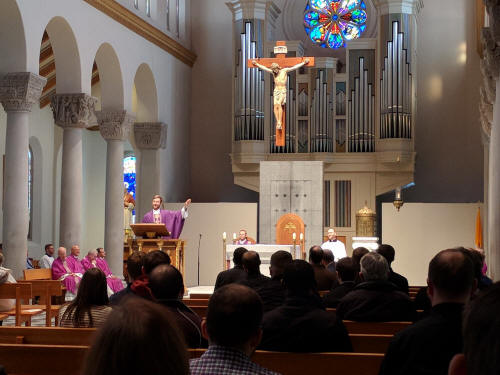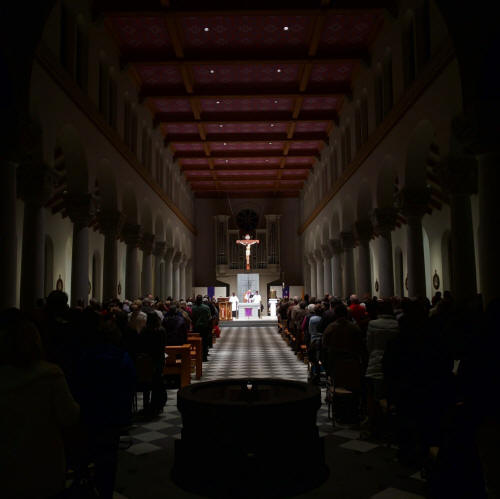|
Builder: Noack Organ Co., Op. 136, (circa 1999). Manuals: 2 Ranks: 27 Action: Mechanical Notes: The new organ in St. Mary's Chapel at St. Paul Seminary was not only to be a fitting instrument for the seminarians' services, but also provide a good example of a fine organ for the parishes which they some day might serve. Perhaps it was a blessing that the planning process took well over 20 years, allowing ideas to ferment, dreams to be molded into reality and, we hope, finding of a valid solution. Our factory files go back to 1979 and a letter from Charles Fisk to Elizabeth Stodola with a proposal for an organ still assuming the old balcony. Later reports included Frank Kacmarcik's stunning renovation of the chapel as eventually realized. In 1989 I had the pleasure of attending early planning sessions with Sue Seid-Martin, as well as with David Jenkins, with whom we were privileged to work through many stages to the final conclusion. To serve a seminary chapel the organ has to address a few special requirements. It must, of course, to be able to lead congregational and choir singing and perform a wide range of organ literature suitable for this setting. In addition, we realized that a congregation of seminarians needs a fuller sound on the one hand and more than just a quiet flute stop for the accompaniment of chant on the other. All of this we aimed to accomplish with no more stops than necessary, making an example of good stewardship. The organ is not a copy of any particular historic style, although some kinship with baroque German organs and nineteenth-century New England organs can be found. The case front was originally to have 16-foot-tall front pipes, but with a somewhat more disciplined approach 8-foot diapasons have been provided for both the Great and Pedal fronts in the upper part of the instrument. Since the organ visually serves as the termination of the (liturgical) east end of the chapel, this de facto reredos needed to be quite tall; at 27 feet the organ is considerably taller than necessary to accommodate the pipework. The Swell division is housed in the lower part of the organ, hidden behind a very simple, delicate grill of the same design as the pipe shades. Noack factory, Fritz Noack, and Organ Historical Society as of 2009. Editor's note: This is one of the most stunning spaces, acoustically and visually, in the Twin Cities and well worth a visit, especially if you have opportunity to hear an organ concert. GREAT ORGAN 16 Bourdon 8 Diapason 8 Chimney Flute 4 Octave 2.2/3 Twelfth 2 Fifteenth 1.3/5 Seventeenth 1.1/3 Mixture IV 8 Trumpet SWELL ORGAN 8 Viola 8 Stopt Flute 4 Principal 4 Recorder 2 Octave 1.1/3 Quinte 2.2/3 Cornet III 8 Cremona PEDAL ORGAN 16 Stopt Bass 8 Octave 8 Gedackt 4 Choral Bass 16 Trombone |
 |
 |
|
 |
|